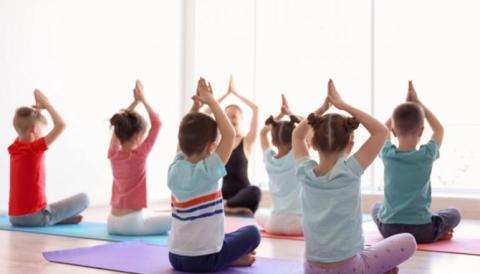Posted on:

10 Reasons Yoga is Good for Children and How the Library Can Help
Yoga has been shown to improve physical and mental health in children. At the library you can find books about yoga for children and adults. You can download an evideo or audiobook. Try a class on one of the aspects of yoga such as meditation on Universal class. You could even join our storybook yoga each month at the library.
- Yoga helps children manage and reduce anxiety. Breathing exercises and relaxation techniques learned while practicing yoga can help children with stress management. Teaching children how to reduce stress in a healthy way is an important life skill that will help them throughout life.
- Yoga improves children’s emotional regulation. Yoga helps children learn to be in the present moment while relaxing and gaining a peaceful state of mind, which ultimately improves their emotional regulation.
- Yoga boosts children’s self-esteem. Perfecting a pose or improving their balance and flexibility can give young children a sense of personal empowerment. Yoga teaches kids to persevere, be patient, and work toward their goals. When they master a new pose or technique, they’ll know they put in the hard work and the result is a confidence boost and improved self-esteem.
- Yoga enhances children’s concentration and memory. The different types of moves require children to focus and work on their memorization skills. Whether maintaining a pose or breathing deeply, yoga encourages children to clear their mind. As a result they learn to focus on the task at hand; improving focus and memory.
- Yoga increases children’s body awareness. Going through a variety of yoga poses helps children learn about their bodies and the movements they’re capable of doing. Yoga teaches kids to use their muscles in new and different ways.
- Yoga teaches children mindfulness. Through breathwork techniques and different types of meditation children can learn mindfulness through yoga. Mindfulness can help kids manage their emotions and tackle challenges and help build key skills like focus and self-control.
- Yoga develops children’s strength and flexibility. Yoga helps strengthen children’s growing bodies including muscles and bones. It also helps improve flexibility, which can reduce their chance of injury.
- Yoga teaches discipline and reduces impulsivity. Yoga can reduce challenging behaviors in the classroom by providing a physical outlet for children to express themselves. It also teaches children about discipline as they work on clearing their minds and perfecting their poses.
- Yoga introduces cornerstone values. When learning all of the facets of yoga and not just the physical poses, children are introduced to a moral code of conduct. Yoga teaches non-harming, truthfulness, moderation, cleanliness, gratitude, and self-discipline.
- Yoga helps the digestive and circulatory systems. According to the American Academy of Pediatrics, yoga helps stimulate the digestive system, helps with constipation, and regulates blood sugar levels and insulin levels.
Yoga’s tendencies to improve concentration, reduce anxiety, and boost problem solving skills are also linked with academic success and improved academic performances. In addition, the AAP recommends yoga as a safe and potentially effective therapy for children coping with emotional, mental, physical, and behavioral health conditions.